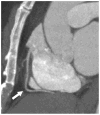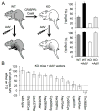ANGPTL3 Deficiency and Protection Against Coronary Artery Disease
- PMID: 28385496
- PMCID: PMC5404817
- DOI: 10.1016/j.jacc.2017.02.030
ANGPTL3 Deficiency and Protection Against Coronary Artery Disease
Abstract
Background: Familial combined hypolipidemia, a Mendelian condition characterized by substantial reductions in all 3 major lipid fractions, is caused by mutations that inactivate the gene angiopoietin-like 3 (ANGPTL3). Whether ANGPTL3 deficiency reduces risk of coronary artery disease (CAD) is unknown.
Objectives: The study goal was to leverage 3 distinct lines of evidence-a family that included individuals with complete (compound heterozygote) ANGPTL3 deficiency, a population based-study of humans with partial (heterozygote) ANGPTL3 deficiency, and biomarker levels in patients with myocardial infarction (MI)-to test whether ANGPTL3 deficiency is associated with lower risk for CAD.
Methods: We assessed coronary atherosclerotic burden in 3 individuals with complete ANGPTL3 deficiency and 3 wild-type first-degree relatives using computed tomography angiography. In the population, ANGPTL3 loss-of-function (LOF) mutations were ascertained in up to 21,980 people with CAD and 158,200 control subjects. LOF mutations were defined as nonsense, frameshift, and splice-site variants, along with missense variants resulting in <25% of wild-type ANGPTL3 activity in a mouse model. In a biomarker study, circulating ANGPTL3 concentration was measured in 1,493 people who presented with MI and 3,232 control subjects.
Results: The 3 individuals with complete ANGPTL3 deficiency showed no evidence of coronary atherosclerotic plaque. ANGPTL3 gene sequencing demonstrated that approximately 1 in 309 people was a heterozygous carrier for an LOF mutation. Compared with those without mutation, heterozygous carriers of ANGPTL3 LOF mutations demonstrated a 17% reduction in circulating triglycerides and a 12% reduction in low-density lipoprotein cholesterol. Carrier status was associated with a 34% reduction in odds of CAD (odds ratio: 0.66; 95% confidence interval: 0.44 to 0.98; p = 0.04). Individuals in the lowest tertile of circulating ANGPTL3 concentrations, compared with the highest, had reduced odds of MI (adjusted odds ratio: 0.65; 95% confidence interval: 0.55 to 0.77; p < 0.001).
Conclusions: ANGPTL3 deficiency is associated with protection from CAD.
Keywords: human genetics; loss-of-function mutations; myocardial infarction.
Copyright © 2017 American College of Cardiology Foundation. Published by Elsevier Inc. All rights reserved.
Figures






Comment in
-
ANGPTL3: A Gene, a Protein, a New Target? Aye, There's the Rub!J Am Coll Cardiol. 2017 Apr 25;69(16):2064-2066. doi: 10.1016/j.jacc.2017.03.015. Epub 2017 Apr 3. J Am Coll Cardiol. 2017. PMID: 28385497 No abstract available.
-
Cardioprotective Properties of ANGPTL3 Deficiency.J Am Coll Cardiol. 2017 Oct 17;70(16):2098-2099. doi: 10.1016/j.jacc.2017.05.086. J Am Coll Cardiol. 2017. PMID: 29025567 No abstract available.
-
Reply: Loss-of-Function Mutations to Estimate Pharmacological ANGPTL3 Inhibition.J Am Coll Cardiol. 2017 Oct 17;70(16):2099-2100. doi: 10.1016/j.jacc.2017.07.794. J Am Coll Cardiol. 2017. PMID: 29025568 No abstract available.
-
Concerns on the Genetic or Therapeutic Antagonism of ANGPTL3.J Am Coll Cardiol. 2017 Oct 17;70(16):2099. doi: 10.1016/j.jacc.2017.06.076. J Am Coll Cardiol. 2017. PMID: 29025569 No abstract available.
Similar articles
-
Genetic and Pharmacologic Inactivation of ANGPTL3 and Cardiovascular Disease.N Engl J Med. 2017 Jul 20;377(3):211-221. doi: 10.1056/NEJMoa1612790. Epub 2017 May 24. N Engl J Med. 2017. PMID: 28538136 Free PMC article. Clinical Trial.
-
Characterization of three kindreds with familial combined hypolipidemia caused by loss-of-function mutations of ANGPTL3.Circ Cardiovasc Genet. 2012 Feb 1;5(1):42-50. doi: 10.1161/CIRCGENETICS.111.960674. Epub 2011 Nov 7. Circ Cardiovasc Genet. 2012. PMID: 22062970
-
Mutations in the ANGPTL3 gene and familial combined hypolipidemia: a clinical and biochemical characterization.J Clin Endocrinol Metab. 2012 Jul;97(7):E1266-75. doi: 10.1210/jc.2012-1298. Epub 2012 Jun 1. J Clin Endocrinol Metab. 2012. PMID: 22659251 Free PMC article.
-
Angiopoietin-like 3 in lipoprotein metabolism.Nat Rev Endocrinol. 2017 Dec;13(12):731-739. doi: 10.1038/nrendo.2017.119. Epub 2017 Oct 6. Nat Rev Endocrinol. 2017. PMID: 28984319 Review.
-
New insights into ANGPLT3 in controlling lipoprotein metabolism and risk of cardiovascular diseases.Lipids Health Dis. 2018 Jan 15;17(1):12. doi: 10.1186/s12944-018-0659-y. Lipids Health Dis. 2018. PMID: 29334984 Free PMC article. Review.
Cited by
-
Understanding Hypertriglyceridemia: Integrating Genetic Insights.Genes (Basel). 2024 Jan 30;15(2):190. doi: 10.3390/genes15020190. Genes (Basel). 2024. PMID: 38397180 Free PMC article. Review.
-
Novel protein-truncating variant in the APOB gene may protect from coronary artery disease and adverse cardiovascular events.Atheroscler Plus. 2022 Jun 23;49:42-46. doi: 10.1016/j.athplu.2022.06.001. eCollection 2022 Aug. Atheroscler Plus. 2022. PMID: 36644201 Free PMC article.
-
Effect of Vupanorsen on Non-High-Density Lipoprotein Cholesterol Levels in Statin-Treated Patients With Elevated Cholesterol: TRANSLATE-TIMI 70.Circulation. 2022 May 3;145(18):1377-1386. doi: 10.1161/CIRCULATIONAHA.122.059266. Epub 2022 Apr 3. Circulation. 2022. PMID: 35369705 Free PMC article. Clinical Trial.
-
Deep-coverage whole genome sequences and blood lipids among 16,324 individuals.Nat Commun. 2018 Aug 23;9(1):3391. doi: 10.1038/s41467-018-05747-8. Nat Commun. 2018. PMID: 30140000 Free PMC article.
-
Antisense Oligonucleotides and Small Interfering RNA for the Treatment of Dyslipidemias.J Clin Med. 2022 Jul 4;11(13):3884. doi: 10.3390/jcm11133884. J Clin Med. 2022. PMID: 35807171 Free PMC article. Review.
References
-
- Koishi R, Ando Y, Ono M, et al. Angptl3 regulates lipid metabolism in mice. Nat Genet. 2002;30:151–7. - PubMed
-
- Shimizugawa T, Ono M, Shimamura M, et al. ANGPTL3 decreases very low density lipoprotein triglyceride clearance by inhibition of lipoprotein lipase. J Biol Chem. 2002;277:33742–8. - PubMed
-
- Shimamura M, Matsuda M, Yasumo H, et al. Angiopoietin-like protein3 regulates plasma HDL cholesterol through suppression of endothelial lipase. Arterioscler Thromb Vasc Biol. 2007;27:366–72. - PubMed
MeSH terms
Substances
Grants and funding
- KL2 TR001100/TR/NCATS NIH HHS/United States
- UM1 HG008895/HG/NHGRI NIH HHS/United States
- T32 HL007734/HL/NHLBI NIH HHS/United States
- R33 HL120781/HL/NHLBI NIH HHS/United States
- R01 HL127564/HL/NHLBI NIH HHS/United States
- RC2 HL101834/HL/NHLBI NIH HHS/United States
- R21 HL120781/HL/NHLBI NIH HHS/United States
- K08 HL114642/HL/NHLBI NIH HHS/United States
- UM1 HG008853/HG/NHGRI NIH HHS/United States
- RG/08/014/24067/BHF_/British Heart Foundation/United Kingdom
- R01 HL131961/HL/NHLBI NIH HHS/United States
- RC1 TW008485/TW/FIC NIH HHS/United States
- R01 HL118744/HL/NHLBI NIH HHS/United States
- U54 HG003067/HG/NHGRI NIH HHS/United States
- MR/L003120/1/MRC_/Medical Research Council/United Kingdom
LinkOut - more resources
Full Text Sources
Other Literature Sources
Medical
Molecular Biology Databases
Miscellaneous

